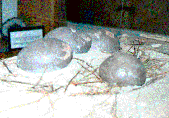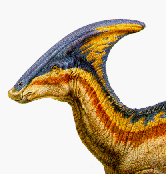 HISTORY OF THE EGG
HISTORY OF THE EGG
 HISTORY OF THE EGG
HISTORY OF THE EGG
The egg was found in a nest of eggs that were oriented with their long axis horizontal. Three of the eggs were aligned along a slight arc, suggesting that they had originally been placed in a spiral pattern. Figure 1 below shows the actual egg as found. Figure 2 shows a wonderfully preserved hadrosaur nest in which the eggs lie in such a spiral pattern. The spiral nest was a characteristic of the ornithischians and was most likely used in order to minimize the size of the nest while keeping the eggs from touching. It also suggests that these dinosaurs recognized geometrical patterns such as the one below (Carpenter and Hirsch, 44).
(Photo from Dinosaur! )

Researchers at the Crater Rock Museum speculate that this fossil egg was laid by a dinosaur belonging to the class of ornithiscians, quite possibly a member of the hadrosaur family and maybe, more specifically, a parasaurolophus. However, that this egg was laid by a parasaurolophus is only speculation. It is quite difficult to the dermine the species of a fossil egg. A researcher cannot assume that fossil remains found near an egg are of the same species that created it. Unless there is an embryo within the egg, a determination of species is most often based upon analysis of the eggshell (observation of microscopic cross-sections of its calcite layers), observation of the fossil egg's external structure, and position of the egg with respect to other eggs, bones, and mineral deposits. In fact, even in the Henan provence, where egg discoveries abound, there are no associated bone remains that give enough information as to determine the origin of the egg.

 (Photo from Dinosaur! )
(Photo from Dinosaur! )
The parasaurolophus was a semi-aquatic creature with webbed feet which, when on land, walked on it's hind legs, and ran on all four. Despite the creature's terrific hind legs (ten times stronger than its forelegs) it was a slower animal than the majority of its enemies. It was also hindered by its lack of sufficient defensive weapons; The claws on the animal's hands were blunt and it posessed no biting teeth. Also interesting to note (and look for in the visualization) is the fact that the backbone of the Parasaurolophus consisted of very long rods which made any extreme twisting at the torso impossible.
This eater of leaves and branches had strong molars allowing it to grind fairly rough plant matter without the use of gastroliths (stones in the stomach for grinding food).
The Parasaurolophus is best known for its characteristic hollow nasal crest and the flat, bill-like appearance of its nasal canal. (Because of this 'bill' the hadrosaur is often refered to as the "duck-billed" dino.) Its nasal canal is twice the length of its skull, extending high off of the forehead. Scientists believe the nasal crest was used to create deep courting calls, much like the sound of an oboe. The young Parasopholus, on the other hand, had a squeaky, high-pitched voice. This dinosaur was a creature of considerable intelligence with had an incredible sense of sight and smell. It travelled in herds and would return to nesting areas seasonally.
 HISTORY OF THE PROJECT
HISTORY OF THE PROJECT
 PALEONTOLOGY
PALEONTOLOGY
 THE PROCESS
THE PROCESS
 IMAGING
IMAGING
 3D ANIMATIONS
3D ANIMATIONS
 CONCLUSIONS
CONCLUSIONS
 REFERENCES
REFERENCES